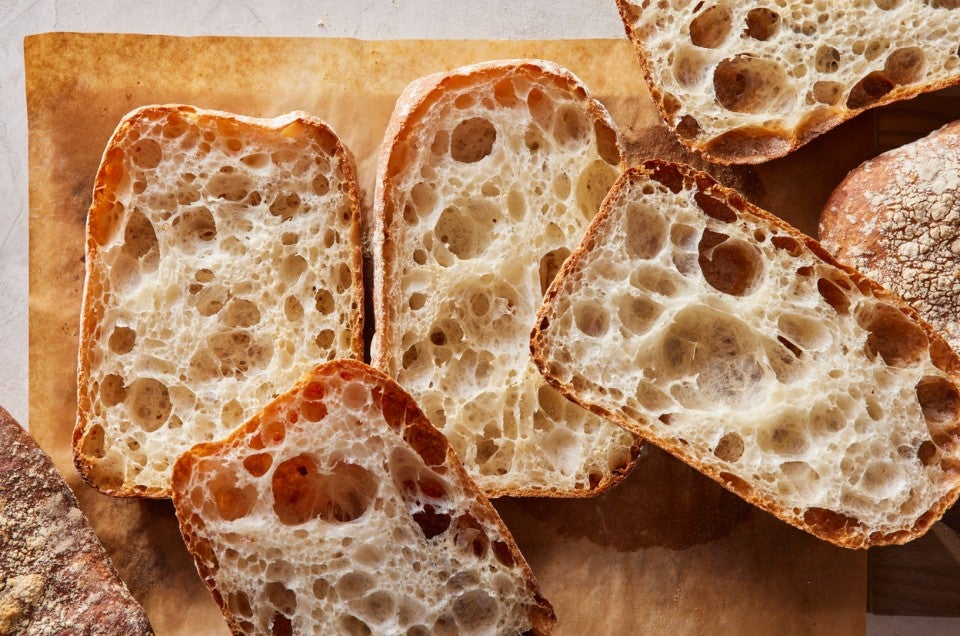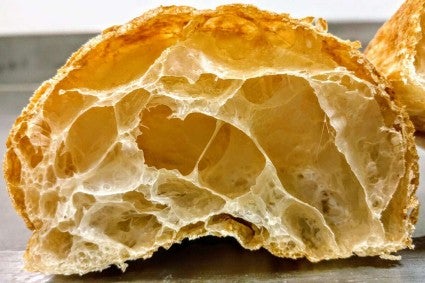Glass bread tastes as good as it looks (and it looks really, really good)
A beautiful bread made possible by bread flour.


 Recently I saw a loaf that stopped me in my tracks. It was a loaf that looked like it had all the qualities of a great bread: flavor, texture, sustenance. And most of all, beauty. Beauty, after all, is half the reason I bake. (Haven't you ever made something just because it’s gorgeous?)
Recently I saw a loaf that stopped me in my tracks. It was a loaf that looked like it had all the qualities of a great bread: flavor, texture, sustenance. And most of all, beauty. Beauty, after all, is half the reason I bake. (Haven't you ever made something just because it’s gorgeous?)
That loaf turned out to be Pan de Cristal, a traditional loaf from the Catalan region of Spain sometimes referred to as "glass bread." The outside of this loaf is unassuming — dark and crusty — and not exactly a showstopper. But wait. Hidden inside, lurking like crystals underneath a crust so crisp it seems fried, is a miraculously beautiful crumb. Threads of gluten stretch into glassy, translucent webs. Is it bread, I thought, or is it treasure?

It's both. And that’s what drew me in. I started asking questions: What magic makes Pan de Cristal possible? Will the recipe require days of attention, special flours, or mystical hands to transform four simple ingredients?
Luckily, I found the answers.
When I explore something new, I always start with architecture. In baking terms, what I mean is that I look inside the loaf at the structural components and ingredient ratios. I also consider method — the mixing, fermentation, and baking — and come up with a list of questions. You’ve seen me do this before from chocolate bread hacks to twists on traditional favorites.
The hydration will need to be dangerously high, around 100% in baker’s percentages (meaning, equal weights of flour and water). Compare this with baguettes (in the range of 65% to 75%) or ciabatta (around 80%), and you may be concerned. I don’t blame you. As designed, the dough will feel more like a batter than bread.
For leavening, I choose commercial yeast. The acidity of a sourdough culture isn't the flavor profile that I want. Let’s keep it simple: malty wheat, a well-baked crust, a drizzle of olive oil. Plus, I have time goals: I’d love to make this bread in a single afternoon. No preferment and a little commercial yeast will speed up the process.
Then there's fermentation. The dough will need time and folds to develop the necessary strength for its final proof. I'm not sure how much of each, but I do know that we’re chasing miracles here. This brings me to the crux of the challenge: How will it be possible to push this wet dough to the edge of its rise without collapsing?
Here’s how: Bread flour.

Sometimes baking requires a superhero. Bread flour, with enough strength to hold tons of water and support a long final proof without collapsing, is the caped hero we need. All-purpose could work but I would need to lower the hydration, sacrificing a key requirement for Pan de Cristal’s signature open structure.
Bread flour is also integral to creating a dough that's smooth, silky, and workable, despite the high hydration.
Early attempts involved yeasted preferments and lots of mechanical mixing. While the bread I made was flavorful, the crumb wasn’t much better than my ciabatta. Back to the drawing board.
First up, I needed to fix the most defining characteristic for this loaf: the holes. Since a long process with extensive mixing didn’t produce what I wanted, I went in the opposite direction: less mixing and a shorter process. My thought was that too much strength as a result of either development (mixing, folding, or time being the contributing factors) or fermentation, made my crumb structure too homogenous, not wildly open.
After several bakes with adjustments to mixing, number of folds, length of fermentation, and final rise, I found myself getting closer. The holes started to open, creating a collage of glassy, translucent bubbles, all connected within a network of random threads. The crust became thinner and crispier as I pushed the final rise further and further. As my cutting board was taken over by the piles of loaves, I began cutting them open as a parlor trick, shocking my family with the incredible results.
But rather than taking a bow after, “Wow, daddy, that’s amazing,” let’s give credit where it’s due. Please stand, a round of applause for bread flour — strong, elastic, ready for all the water and fermentation we can throw at it — the true star of this show.
So, if you'd like to see this transformation in action, give the recipe a whirl. Mix the dough just before noon, fold a few times between errands, Zoom meetings, dinner preparation, and life, and you'll have a hero at the table by dinnertime. Cue the applause!

In testing, enjoying, and sharing many loaves of Pan de Cristal, here are some things that I found helpful.
Just keep folding. On the flip side, if your dough doesn't match my above video exactly, or if you feel like it's more suited for pancakes than Pan, keep going. Unless there's a mistake with your measurements of flour or water, and as long as you're using great flour, the dough will definitely come around.
If you make this Pan de Cristal, please let us know — tag your photos #bakeoftheweek and maybe give @kingarthurbaking a shout-out, too. Happy baking!


October 14, 2024 at 1:59pm
Is it possible to cook final product in dutch oven instead of making smaller square loaves?
October 15, 2024 at 1:30pm
In reply to Is it possible to cook final… by Jane (not verified)
Hi Jane! Because of the high hydration of this recipe, you would not want to use the lid of the Dutch oven as it would produce way too much steam. Additionally, this dough is extremely difficult to handle so getting it into a shape other than a rectangle would be a risky situation. You could always start the dough in a bowl rather than a rectangular container, however you might not get the full effect of the coil folds using a bowl. Overall, I would not recommend it. Happy baking!
March 31, 2024 at 1:28pm
Rubbish recipe, why is every recipe posted on the web always useless
April 4, 2024 at 6:10pm
In reply to Rubbish recipe, why is every… by Nigel Watson (not verified)
Sorry to hear you feel this way, Nigel. Our bakers are always happy to help with any recipe questions at (855) 371-2253 (BAKE).
May 1, 2024 at 9:57am
In reply to Rubbish recipe, why is every… by Nigel Watson (not verified)
Now that's a totally useless comment - did you try the re ipe? What went wrong..? I am a novice baker - I followed the recipe and instructions closely - the result was absolute perfection both times. It is my go-to recipe for bread.
July 2, 2024 at 10:00am
In reply to Now that's a totally useless… by Brian (not verified)
The BEST recipe ever!!! This is my go to bread!!
February 27, 2024 at 4:28pm
Hi Martin I will be making this bread it looks delicious; I have made your Bread de Campagne; this question is about that bread if you don't mind; I tried making my leavening again and again & it hasn't worked out for me; I made the BdeC with poolish I made from the night before; it works but am sure it doesn't taste like yrs; can you give us a recipe that works; & 2ndly can I bake the bread same day without the fridge if I start early.
March 3, 2024 at 11:28am
In reply to Hi Martin I will be making… by Tula Gianni (not verified)
Hi Tula, it sounds like you've had trouble getting a sourdough starter up and running? We do have this sourdough starter recipe, and our Baker's Hotline is always happy to help troubleshoot if you run into difficulties along the way. We're here M-F from 9am-9pm EST, and Saturday and Sunday from 9am-5pm EST, and the number to call is 855-371-BAKE (2253). We also sell a fully mature sourdough starter that just needs a few feedings to revive it from its travels before it's ready to use in your bread baking.
As far as making the Pain De Campagne recipe all in one day, this isn't something we've tried, but I would think it's possible. And if you get tired and want to leave the shaped loaves in the fridge overnight, that is always an option.
January 19, 2024 at 2:51pm
I made this recipe and it generally worked well, but when I sliced it open I seemed to have a lot of big bubbles/holes in the upper half, but relatively fewer/smaller holes in the bottom half. I tried to be gentle and use parchment but there’s no getting around having to separate the quarters; was I inadvertantly deflating the dough too much when manipulating the sections? How do you cut them and move them with puncturing them?
January 27, 2024 at 2:36pm
In reply to I made this recipe and it… by Caite M (not verified)
Hi Caite, a certain amount of deflation is bound to happen when you divide the dough, so I don't think that's what caused the issue you described. Rather, this is likely to be related to dough strength and proofing. Sometimes larger bubbles at the top of the bread can indicate that the dough is a bit over-proofed, which can contribute to the gluten structure beginning to break down. When this happens, the gluten isn't as able to hold the fermentation bubbles in place throughout the loaf, and they end up rising to the top of the loaf and gathering under the crust. This could happen if your dough was on the warmer side or proofed longer than recommended. If this sounds like what happened, you might find that baking the bread a bit earlier (when the bread hasn't risen quite so much) may prove helpful. On the other hand (and just to make things more confusing), if you weren't able to develop sufficient dough strength and under-proofed the loaves, you may see a similar pattern of large holes on top. This would be more likely to happen if your dough was slack and on the cool side. I would focus on developing good dough strength through the folds, be sure to use our bread flour, and try to keep the dough in the 74°F to 76°F range after mixing and throughout the folds and rise times. This will help the timing indicated in the recipe match up with the actual dough progress.
Pagination